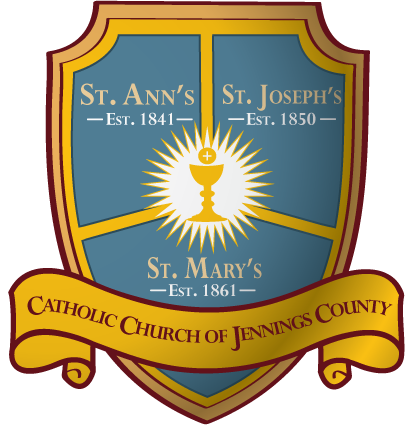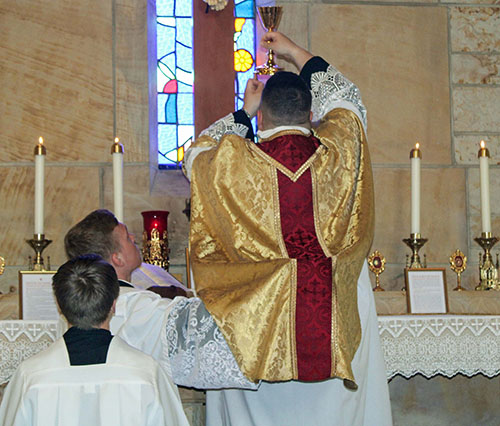Liturgy
What happens in the Liturgy?
What is Liturgy?
"The liturgy is the summit toward which the activity of the Church is directed; at the same time it is the fount from which all the Church's power flows." ~Constitution on the Sacred Liturgy, #10
The word “liturgy” comes from the Greek “leitourgia” meaning “a work on behalf of the people.” This work is stressed by the importance of the liturgy in the life of Catholics and the life of the Church because we can do all things through Christ. Apart from Him, we are nothing. (John 15:5)
The Catechism of the Catholic Church also declares, ”In the liturgy of the Church, God the Father is blessed and adored as the source of all blessings of creation and salvation… the whole liturgical life of the Church revolves around the Eucharistic sacrifice and the sacraments.”
While there are other forms of prayer that take their foundation from the Holy Scripture, such as the Liturgy of the Hours, traditional devotions, such as to the Sacred and Immaculate Hearts, the Rosary, and adoration, the Church teaches that all these lead to the Sacred Liturgy of the Church which is the Eucharist and the Holy Mass. The enthusiastic participation of the people of God – the sacred assembly – is an important role.
According to St. Thomas Aquinas, “The whole rite of the Christian religion is derived from Christ’s priesthood,” for in virtue of the indelible marks, or characters, we receive in baptism and confirmation, “the faithful are likened” to Christ; these characters “are nothing else than certain participations of Christ’s priesthood, flowing from Christ himself” (“Summa Theologiae,” part 3, q. 63, art. 3).
What happens in the Liturgy?
In the sacred liturgy, especially the Eucharist, we enter into the kingdom made present now, into the heavenly liturgy where Christ is the “Lamb standing, as though it had been slain” (Rev 5:6).
Please join us every Sunday and in our weekday liturgies as well, all for the glory of God!
Mass Schedule
The word “liturgy” comes from the Greek “leitourgia” meaning “a work on behalf of the people.” This work is stressed by the importance of the liturgy in the life of Catholics and the life of the Church because we can do all things through Christ. Apart from Him, we are nothing. (John 15:5)
The Catechism of the Catholic Church also declares, ”In the liturgy of the Church, God the Father is blessed and adored as the source of all blessings of creation and salvation… the whole liturgical life of the Church revolves around the Eucharistic sacrifice and the sacraments.”
While there are other forms of prayer that take their foundation from the Holy Scripture, such as the Liturgy of the Hours, traditional devotions, such as to the Sacred and Immaculate Hearts, the Rosary, and adoration, the Church teaches that all these lead to the Sacred Liturgy of the Church which is the Eucharist and the Holy Mass. The enthusiastic participation of the people of God – the sacred assembly – is an important role.
According to St. Thomas Aquinas, “The whole rite of the Christian religion is derived from Christ’s priesthood,” for in virtue of the indelible marks, or characters, we receive in baptism and confirmation, “the faithful are likened” to Christ; these characters “are nothing else than certain participations of Christ’s priesthood, flowing from Christ himself” (“Summa Theologiae,” part 3, q. 63, art. 3).
What happens in the Liturgy?
In the sacred liturgy, especially the Eucharist, we enter into the kingdom made present now, into the heavenly liturgy where Christ is the “Lamb standing, as though it had been slain” (Rev 5:6).
- We are drawn into eternity and participate in the eternal self-offering of Christ who offered himself upon the cross.
- It is the proclamation to all mankind of the Gospel (the good news) of his triumphal death and glorious resurrection: “When I am lifted up from the earth, I will draw all men to myself” (Jn 12:32)
- Our participation in Christian worship is real. It is more than a memory of a past event more than 2,000 years ago, but a perpetual sacrifice done once to redeem us.
- However, it comes into our space and time to transform us through the Holy Spirit. At the Mass, we are at Calvary in our space and time.
- As the Second Vatican Council teaches, “The liturgy is the summit toward which the activity of the Church is directed … it is the font from which all her power flows” (“Sacrosanctum Concilium” 10).
- As Catholics, we believe that the bread and wine are consecrated by the priest into the body and blood of Christ: body, blood, soul, and divinity.
- At every Mass, when we hear the words of Jesus, “Do this in memory of me."
- "Mother Church earnestly desires that all the faithful should be led to that full, conscious, and active participation in liturgical celebrations which is demanded by the very nature of the liturgy. Such participation by the Christian people as "a chosen race, a royal priesthood, a holy nation, a redeemed people (1 Pt 2:9; cf. 2:4-5), is their right and duty by reason of their baptism." (Constitution on the Sacred Liturgy, #14)
Please join us every Sunday and in our weekday liturgies as well, all for the glory of God!
Mass Schedule
Interested in Becoming Catholic?
Perhaps one of the best ways to learn more about the Catholic faith is to listen to the stories of others. Here are three videos from Fr. Jerry Byrd, our former pastor, about his journey to the Catholic Church and how that path led to the priesthood.


 Catholics often confuse “Mass in Latin,” with the “Latin Mass,” thinking they are the same liturgy. However, they are two different Masses with similarities.
Catholics often confuse “Mass in Latin,” with the “Latin Mass,” thinking they are the same liturgy. However, they are two different Masses with similarities.
